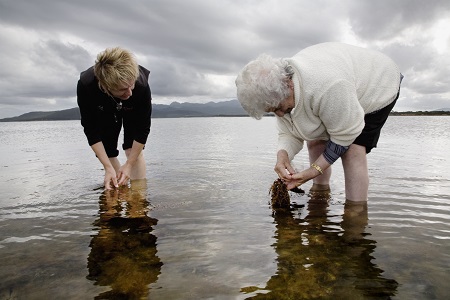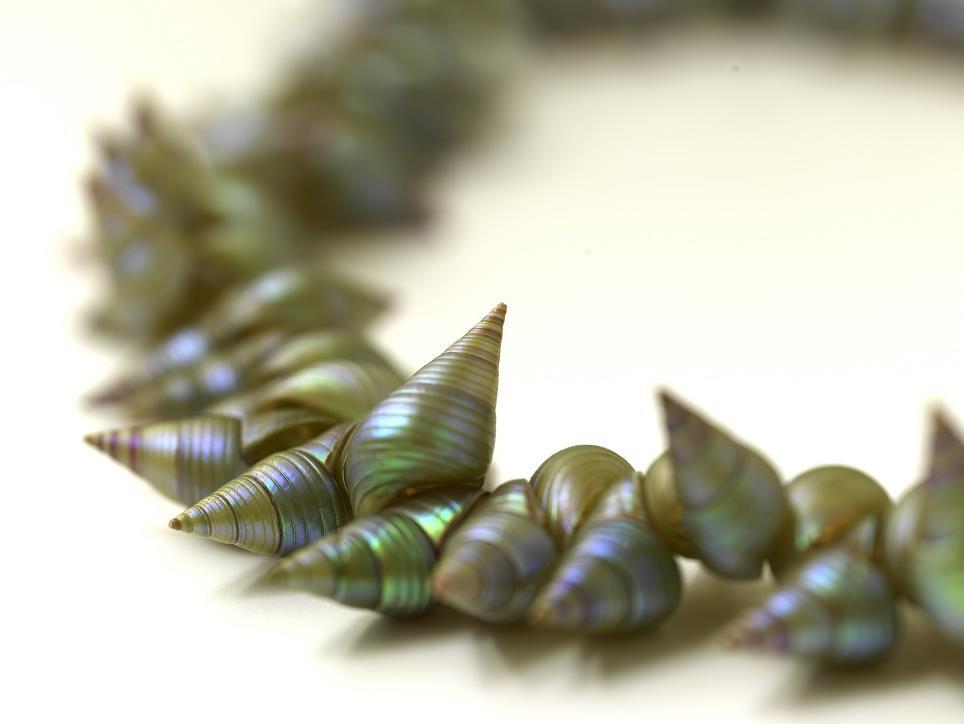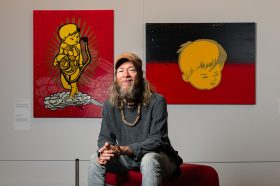Ashlee Murray (b. 1987) King marina shells. Wynyard 2016 Purchased TMAG Foundation 2016. Image: Tasmanian Museum and Art Gallery.
A new exhibition at the Tasmanian Museum and Art Gallery (TMAG) demonstrates the resilience of the local Tasmanian Aboriginal community and the power of the museum to support the continuation of culture.
Visitors can see a 19th century necklace collected by George Augustus Robinson who took the string of shells back to England after his travels in Tasmania. Finally, this significant historical piece has returned to Tasmania for the first time in more than 160 years.
Next to the returned shell necklace, visitors will see another by one of the community’s eldest stringer, who is ninety-three, and one by the youngest exhibiting stringer, who is six. It is a curation that speaks volumes about longevity, continuity and change.
‘It shows the strength and resilience of the women in the community through such an important cultural practice,’ said Zoe Rimmer, Senior Curator of Indigenous Cultures at TMAG.
kanalaritja: An Unbroken String is a major touring exhibition from TMAG and offers a unique insight into the practice of shell stringing, one of the longest living and most closely guarded traditions by the local Tasmanian Aboriginal community. It opened in Hobart in December where it will remain on display until 21 May 2017, before commencing a two year national touring itinerary.
Where to see kanalaritja: An Unbroken String
From relic to renaissance
The exhibition came together after the success of the luna tunapri workshops, in which the museum worked with the local Aboriginal community to help preserve and revitalise the art form for a new generation.
‘Lola Greeno, who is one of our best known senior shell stringers, came to us with the idea. She said that, basically, there were only a dozen or so stringers left in the community who had all the knowledge needed to make shell necklaces and so she wanted to work with us to facilitate a series of workshops to get a new generation of women involved, particularly women from families who haven’t previously had the opportunity – families that may have lost a grandmother or mother before the knowledge was passed on.’

luna tunapri workshop, Flinders Island 2011; Image: Lucia Rossi.
Three of the community’s senior stringers, Aunty Dulcie Greeno, Aunty Corrie Fullard and Jeanette James, led the workshops that brought many women together to learn the process of collecting, cleaning and stringing shells. TMAG shares this journey through the exhibition.
These workshops are part of a new approach that started with TMAG working in close collaboration with the Tasmanian Aboriginal Community on cultural revival projects.
‘We started really looking at the collection with the community quite a few years ago and the first cultural revival project we ran was a canoe building project,’ said Rimmer.
‘TMAG holds some small model canoes that were made in the 1840s and we wanted a big canoe for one of our new exhibitions at the time. That got a group of men together who started looking at the models and the records. We even had the models cat-scanned to be able to see the internal structure, and then from that they created this full sized canoe for the exhibition. It was the first time it was done in about 170 years.’
Since the canoe building project, the men who participated have taught other men in the community. Canoes are now being built regularly for festivals, for individual use and other museums and galleries are starting to collect them.
‘From there, everybody got enthused about how we can start re-looking at the collections for more contemporary cultural practices,’ said Rimmer.
These cultural revival projects and the significant engagement with the Tasmanian Aboriginal community that underlies the management of TMAG’s collection is a break with the institution’s past.
‘The TMAG is one of the oldest museums in Australia and so has had a difficult history in the way it treated the Tasmanian Aboriginal community in the past. More recently the museum has slowly but steadily been building better relationships with the community. For both myself and my co-curator, we are both Tasmanian Aboriginal, so it is about getting our community in the museum to manage the collection and to build that relationship and support the community in whatever way we can to help maintain and revive cultural practices and to also promote that through exhibitions.’
‘It is about working in collaboration and supporting the community in what the community want to do with our cultural practices.’

luna tunapri workshop, Bruny Island 2011. Image: Lucia Rossi.
Rimmer said many museums hold culturally significant collections and in some cases these institutions can house some of the only pieces that have survived over time. This means the role of contemporary museums has evolved and now often plays an important role in the revival or maintenance of cultural practices.
‘It’s kind of ironic that these collections were traditionally formed by people who were collecting the material thinking it was going to be the last one – that these objects were seen as relics in a way, relics of a supposedly “dying culture”. But they’ve now become something that can be really inspirational and show continuity as well as adaptation and survival – they are tangible links to our ancestors. Through the development of Community-driven cultural projects and exhibitions we can give voice and life back to historical collections and emphasise resilience over loss’ said Rimmer.
More information about the touring TMAG exhibition can be found here http://kanalaritja.tmag.tas.gov.au/exhibition/





